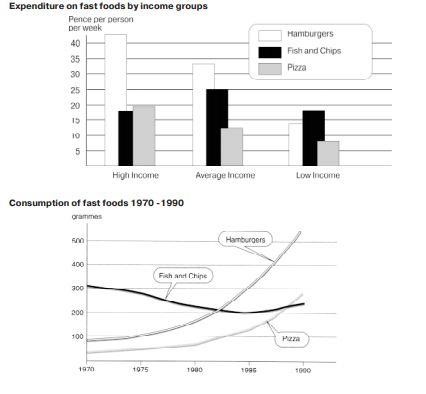The chart below shows the amount of money per week spent on fast foods in Britain. The graph shows the trends in consumption of fast foods.
Write a report for a university lecture describing the information shown below.
The supplied bar graph gives the data regarding the British people’s expenditure made on three kinds of fast food and the line graph illustrates the amount of the same junk food items consumed by them from 1970 to 1990, a period of 20 years. Units for both are measured in pence per person per week and grams respectively.
Overall, people earning higher salaries spent more on junk food and hamburgers became the most eaten fast food item with the passage of time.
At the fleeting glance, high income earners consumed relatively more fast foods than the other income groups, spending more than twice as much on hamburgers with 43 pence per person per week than on fish and chips or pizza with both under 20 pence. Average income earners also favoured hamburgers, spending 33 pence per person per week, followed by fish and chips at 24 pence and pizza at 11 pence. Low income earners appeared to spend the least on junk food, though fish and chips remained most preferred among them, followed by hamburgers and then pizza.
Probing further, in 1970, fish and chips were twice as popular as burgers, and pizza at that time was the least consumed fast food. The consumption of hamburgers and pizza went up steadily over the 20-year period while the consumption of fish and chips declined with a brief rise in its popularity from 1985 to 1990. Pizzas, which were consumed hardly 50 grams a year in the initial years overtook the consumption of fish and chips in the late 1980s finishing at slightly below 300 grams in 1990, whereas consumption of hamburgers exceeded the ingestion of fish and chips in the early 1980s and escalated to finish at above 500 grams in the end of the given period.

